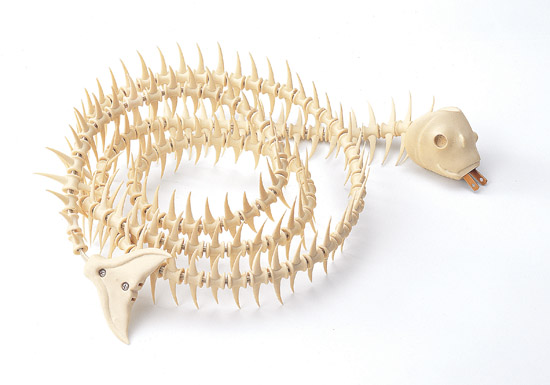On the surface, it looks like just an adorable cartoon musical note. Its understated dot eyes and line mouth make it seem like something you could find at the Hello Kitty store.
But when you pinch its “cheeks” and slide your finger along its stem, it responds by singing out a strange “wah-wah,” its pitch varying with the position of your finger. It’s an instrument. It’s cute. It’s kind of weird. And it’s really fun. And that’s entirely the point.
Welcome to the Gadget OK! symposium and exhibit.
“Art doesn’t have to be too serious. It can have a kind of playful surface, with many serious, critical layers,” said Machiko Kusahara, Gadget OK! organizer and co-curator. “In fact, it attracts many people, and it gives more opportunities for people to think about what art is.”
This philosophy can be seen in many of the pieces featured at the symposium, which runs today and Friday at the Eli and Edythe Broad Art Center, and today through March 4 at the Art | Sci Gallery. Deceivingly simple and fun devices hide small engineering wonders, as in the aforementioned note, called the Otamatone.
“To make technology transparent is important,” Kusahara said.
And in the same way that art can be transformed into a piece of technology, technology just as easily becomes reimagined as an artistic statement. An ordinary extension cord, for example, takes the shape of an elongated fish skeleton, a reminder of the dangers of electricity.
“It’s just an extension cable, it’s not a highÂ-end technology at all. But actually, this visualizes what electricity is. We forget that we can be electrified,” Kusahara said. “All these crazy things have that kind of nature.”
This bridging of art and technology is a major theme for the Gadget OK! exhibit. For some of the organizers and artists, the artistic trend is the result of the leaps technology has made over recent years.
“Nowadays, technology is getting more advanced, and it’s not only just an industrial practice, but at the same time it can be domestic. It can get into people’s lives,” said Eric Siu, a graduate student in Design | Media Arts, artist and co-curator. “I think it’s an interesting phenomenon that people are more accepting of this kind of culture.”
Part of the fun is discovering ways to go beyond the looks and functionality of everyday objects.
“It’s really challenging to form a design that can expand, for instance, a USB memory stick. Why is it necessary for it to look like a USB memory stick? What if it doesn’t look like a memory stick?” Siu said. “It often ends up having multiple meanings to it.”
In many ways, the exhibit is about making art more approachable, which is part of the aim of the interactive and commercialized projects featured at the show.
Part of the appeal of the pieces is their mass production and commercial availability. This comes in direct opposition with the traditional art world, where originals or limited copies can be highly valued and expensive.
“We now live with digital reproduction technology,” Kusahara said. “It makes no difference between the original and the copy. Maybe the border between art and design and commercial products is not so clear anymore.”
But at the end of the day, after all the layers, there seems to be at Gadget OK! one overarching message that stands out.
“It’s not like high art, it’s something that is very accessible to the public,” Siu said.
